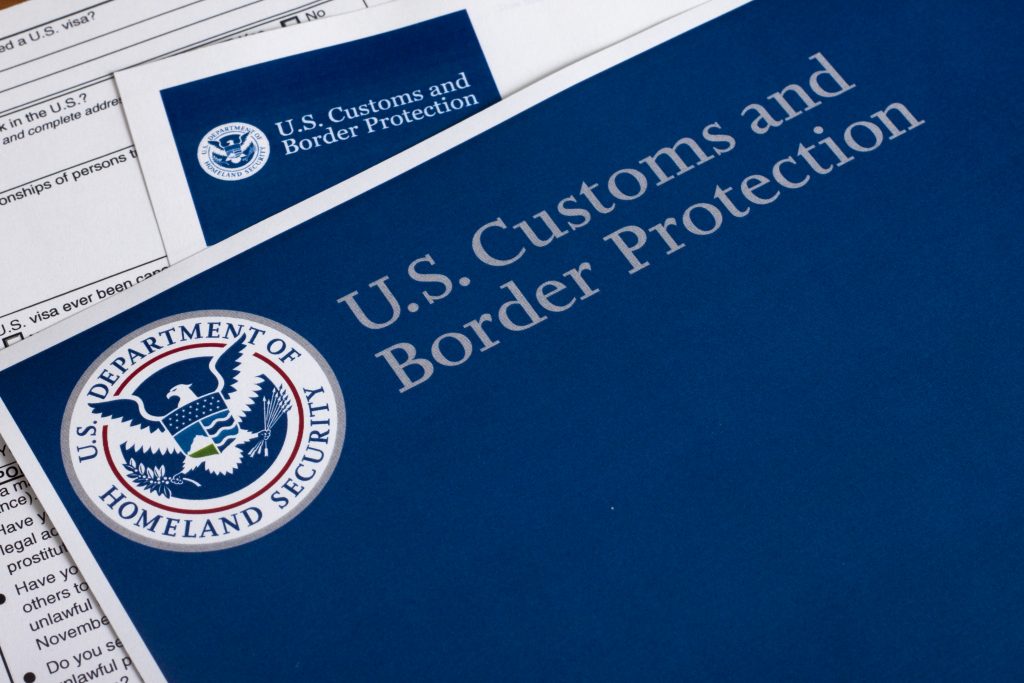“In several recent cases, enhanced CBP authority would have been a more timely and cost-efficient tool to stop design-patent infringement than the existing enforcement forums. In many cases, accused infringers do not appear when sued in district court.”
 Yesterday, the Counterfeit Goods Seizure Act of 2019 was introduced in the U.S. Senate to empower U.S. Customs and Border Protection to enforce U.S. design patents at the U.S. border. The bill is co-sponsored by Senators Thom Tillis (R-NC), Chris Coons (D-DE), Bill Cassidy (R-LA), and Mazie Hirono (D-HI).
Yesterday, the Counterfeit Goods Seizure Act of 2019 was introduced in the U.S. Senate to empower U.S. Customs and Border Protection to enforce U.S. design patents at the U.S. border. The bill is co-sponsored by Senators Thom Tillis (R-NC), Chris Coons (D-DE), Bill Cassidy (R-LA), and Mazie Hirono (D-HI).
Currently, Section 1595a(c)(2)(C) of Title 19 of the U.S. Code empowers Customs to enforce copyrights and trademarks that have been previously recorded with Customs. The bill proposes amending 19 U.S.C. § 1595a(c)(2)(C) to give Customs similar discretionary power to seize and detain imported goods that infringe a recorded U.S. design patent. The bill is publicly supported by Nike Inc. and the 3M Company, as well as the Intellectual Property Owners Association (IPO) and the American Intellectual Property Owners Association (AIPLA).
Counterfeiters have become more clever in the 21st century. Illegitimate manufacturers and sellers have recognized that counterfeit products (which bear infringing trademarks) are potentially at-risk to seizure by agents at the border, but the very same products not bearing the infringing trademarks generally evade seizure by Customs. In 2018, federal authorities arrested a group of counterfeiters who had imported over $70 million in fake Nike shoes—specifically Jordan branded shoes—by omitting labels to evade Customs officials. The U.S. Joint Strategic Plan on IP Enforcement notes that another technique used by counterfeiters is to cover or obscure the trademark and later remove the cover or the obscuring element after the goods clear Customs in order to complete the counterfeiting process. Amending the law to empower Customs to enforce design patents would go a long way towards plugging these loopholes.
The U.S. Joint Strategic Plan also described the ramifications of these counterfeiting techniques. In addition to the large negative fiscal impact that counterfeit goods have on the U.S. economy, the report also noted that the goods may pose consumer safety concerns. For example, the Joint Strategic Plan reported on the risk to consumer health and safety posed by counterfeit versions of personal care products, consumer electronics, and automotive parts, all of which are often protected by design patents. According to the Plan, counterfeit personal care products (e.g., sunscreen, cosmetics, and perfume) often include dangerous contaminants (e.g., carcinogens and urine) or lack the effective ingredients (e.g., SPF). Likewise, counterfeit consumer electronics (e.g., power adapters, chargers, and devices) may fail or overheat leading to fire and electrocution risks. Counterfeit automotive parts (e.g., wheels, headlights, and windshields) often have higher failure and malfunction rates than genuine parts.
The infringement test for design patents was simplified in 2008, which should make it easier for Customs officials to evaluate infringement of a design patent. Customs officers would only have to determine whether the patented design and the suspect imported design were substantially the same in overall appearance. See Egyptian Goddess, Inc. v. Swisa, Inc., 543 F.3d 665 (Fed. Cir. 2008). This analysis is similar to the analysis currently undertaken by Customs in cases of suspected trademark infringement. Customs officers have already effectively demonstrated the ability to determine whether imported goods infringe a design patent, through its ongoing enforcement of design-patent exclusion orders. But, as the amendment is currently drafted, in the event Customs is unable to concretely determine a violation, the agency would have the discretion not to seize the goods, because, as with violations of copyright and trademark, CBP’s authority to seize is discretionary (e.g., “The merchandise may be seized and forfeited if . . . .”).
In several recent cases, enhanced CBP authority would have been a more timely and cost-efficient tool to stop design-patent infringement than the existing enforcement forums. In many cases, accused infringers do not appear when sued in district court. See, e.g., Deckers Outdoor Corp. v. Alphabetdeal.com, Inc., 2018 WL 6133705 (C.D. Cal. Aug. 1, 2018) (court entered default judgment and awarded Deckers $200,000 in damages and issued an injunction). In other cases, rights holders have difficulty identifying the sellers of the accused products. See, e.g., Altinex Inc. v. Alibaba.com Hong Kong Ltd., 2016 WL 6822235 (C.D. Cal. Mar. 25, 2016) (plaintiffs could not identify third party sellers and the court entered judgment as a matter of law in favor of the online marketplace). These design rights could have been enforced at the border by Customs, if Customs had the authority, which would have been faster and less expensive for the design rights holders.
If the bill is enacted, the United States will join many other countries that already have enforcement of design rights at their borders, including the EU, Japan, South Korea, China, India, Mexico, Turkey, Argentina, South Africa, Switzerland, and Panama.
Image Source: Deposit Photos
Image ID: 78973234
Copyright: danielfela

![[IPWatchdog Logo]](https://ipwatchdog.com/wp-content/themes/IPWatchdog%20-%202023/assets/images/temp/logo-small@2x.png)

![[Advertisement]](https://ipwatchdog.com/wp-content/uploads/2024/04/UnitedLex-May-2-2024-sidebar-700x500-1.jpg)
![[Advertisement]](https://ipwatchdog.com/wp-content/uploads/2024/04/Artificial-Intelligence-2024-REPLAY-sidebar-700x500-corrected.jpg)
![[Advertisement]](https://ipwatchdog.com/wp-content/uploads/2024/04/Patent-Litigation-Masters-2024-sidebar-700x500-1.jpg)

![[Advertisement]](https://ipwatchdog.com/wp-content/uploads/2021/12/WEBINAR-336-x-280-px.png)
![[Advertisement]](https://ipwatchdog.com/wp-content/uploads/2021/12/2021-Patent-Practice-on-Demand-recorded-Feb-2021-336-x-280.jpg)
![[Advertisement]](https://ipwatchdog.com/wp-content/uploads/2021/12/Ad-4-The-Invent-Patent-System™.png)






Join the Discussion
6 comments so far.
angry dude
December 18, 2019 09:05 pmJacek the “troll”@5
Dude, I am just venting out..
BUT design patents on the shape and other external features of smartphones would not be needed without utility patents on the smartphone internals
Utility patents come first, like a decade before design patents, at least for smartphones
Jacek the “troll”
December 15, 2019 01:22 pm“Junk design patent” has the full value they deserve in “industrial design registration” absent from nonsense dominated US reality. Also how you expect customs can distinguish between (for example) real “Viagra” Pill and ” Viagra” pill made from gypsum in China. They look exactly the same. Plus the “junk design patent” not fully damaged comparing to “Utility” by ‘efficient infringement lobby” still offers the possibility to collect from an infringer in the US.
angry dude
December 14, 2019 08:11 pmSo exciting…
Apple’s “Steve Jobs” worthless junk design patents on “rectangular phones” and such will be enforced at the border, by my utility patent on internals of those same phones will continue to be ignored ???
Screw US Patent system !
Jacek the “troll”
December 8, 2019 06:07 amIt is a common-sense solution to real problems. Of course, not perfect but who expects any fairness from US patent laws.
mike
December 7, 2019 06:38 pmSo if Apple has a design patent on some design component of the iPhone, and Samsung brings an infringing phone across the border, they will be stopped.
But if Qualcomm has a utility patent on some functionality component in a smartphone, and Apple brings an infringing iPhone across the border, they can carry on?
Because such “carrying on” promotes the Progress of Science and Useful Arts?
How is this fair? And this is just Qualcomm. What about everyone else?
Jacek the “troll”
December 7, 2019 02:56 pmHalleluja. Common sense is finally coming to our shores. What about really joining the Hague agreement as the other 90 countries did? As a designer, I will be able to register up to 100 versions of one design. Right now USPTO is stiffing innovation requiring instead to apply for a number of design patents (and pay the FEES for each one and wait for answer 2 years) and if they refuse one version it becomes an automatically available loophole for an infringer to use. It is a minefield.
Since most designs have life shorter than the 2 years we are effectively barred from protecting our design IP when in any of the 90 countries I can have instant real protection, not only for meaningless ornamentation but most importantly shape of the actual product. (Industrial design registration)